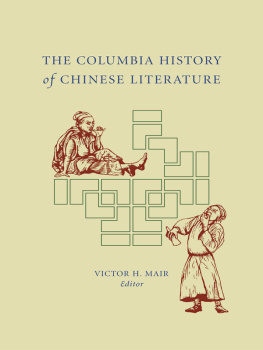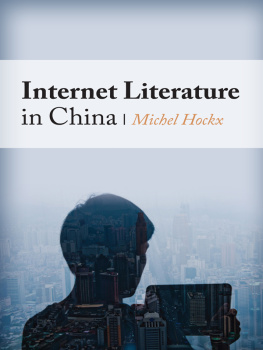An Outline of Chinese Literature II
Different from previous researches weighted toward historical description and individual writer and work, this book establishes a general analytical system and a multi-angled methodology to examine Chinese literature.
In ancient China, there was no definite concept of pure literature. Considering both modern ideas of literature and the corresponding traditional concept, this book broadly discusses Shi and Fu poetry, Ci poems and Qu verses, novels and essays. The four chapters deal with the origins, evolutions, structures and styles of the various genres respectively, analyzing some representative works. Its worth mentioning that the book is written from an individual perspective. Based on his own appreciation as a reader, the author expresses the depth of his various related impressions on Chinese literature. In addition, it conveys many fresh points of view, which will enrich and inspire related researches.
This book will appeal to scholars and students of Chinese literature and comparative literature. People who are interested in Chinese literature and Chinese culture will also benefit from this book.
Yuan Xingpei is a professor of Department of Chinese Language and Literature, Peking University. His research focuses on Chinese classic literature, especially Chinese poetical art.
China Perspectives Series
The China Perspectives series focuses on translating and publishing works by leading Chinese scholars, writing about both global topics and China-related themes. It covers Humanities & Social Sciences, Education, Media and Psychology, as well as many interdisciplinary themes.
This is the first time any of these books have been published in English for international readers. The series aims to put forward a Chinese perspective, give insights into cutting-edge academic thinking in China, and inspire researchers globally.
For more information, please visit www.routledge.com/series/CPH
Existing title:
Beyond the Iron House: Lu Xun and the modern Chinese literary field
Sun Saiyin
Forthcoming titles:
Literature and Literary Criticism in Contemporary China
Zhang Jiong
Literature and Literary Theory in Contemporary China
Zhang Jiong
An Outline of Chinese Literature I
Yuan Xingpei
An Outline of Chinese Literature II
Yuan Xingpei
Seven Lectures on Wang Guoweis Renjian Cihua
Florence Chia-Ying Yeh
An Outline of Chinese Literature II
Yuan Xingpei
Translated by Paul White

First published 2018
by Routledge
2 Park Square, Milton Park, Abingdon, Oxon OX14 4RN
and by Routledge
711 Third Avenue, New York, NY 10017
Routledge is an imprint of the Taylor & Francis Group, an informa business
2018 Yuan Xingpei
The right of Yuan Xingpei to be identified as author of this work has been asserted by him in accordance with sections 77 and 78 of the Copyright, Designs and Patents Act 1988.
All rights reserved. No part of this book may be reprinted or reproduced or utilised in any form or by any electronic, mechanical, or other means, now known or hereafter invented, including photocopying and recording, or in any information storage or retrieval system, without permission in writing from the publishers.
Trademark notice: Product or corporate names may be trademarks or registered trademarks, and are used only for identification and explanation without intent to infringe.
British Library Cataloguing-in-Publication Data
A catalogue record for this book is available from the British Library
Library of Congress Cataloging-in-Publication Data
A catalog record for this book has been requested
ISBN: 978-1-138-24255-5 (hbk)
ISBN: 978-1-315-27789-9 (ebk)
Typeset in Times New Roman
by Apex CoVantage, LLC
Contents
Part 1
Shi and fu poetry
Part 2
Ci poems and qu verses
Part 3
The novel
Part 4
Essays
In September 1987 I was invited by Professor Nagashima of Japans Aichi University to teach an outline course in Chinese literature. On my way back home via Hong Kong personages in Hong Kongs publishing circles, on seeing my lecture notes, decided that they deserved to be published, and so they were sent to the printer. Due to their kind care, this small volume came to be presented to the readers.
Although this book was written for foreigners who wish to study Chinese literature, the requirements of the Chinese reader have also been fully taken into account. For a long time our research into Chinese literature has been weighted toward historical description and discussions of individual writers and works, and too little attention has been paid to many other aspects of the subject as well as to an overall analysis. The style of writing literary history has hardened into a rigid model one it is not easy to break away from. In these circumstances, it is hoped that this attempt to expound on Chinese literature using the method of an outline can provide the readers with fresh perspectives and awaken in them a deeper interest in the subject.
In the course of compiling this book I have consulted a wide range of authorities and studies, and duly noted where I am indebted to them. Some have pointed me in the direction of deeper consideration, and some have furnished me with clues for my research. Although I am not able to cite them one by one, let me take this opportunity to thank them all here. I may mention for special thanks for their assistance Mr. Guo Shaoyu, author of A History of Chinese Literary Criticism, Mr. Chu Binjie, author of An Introduction to Ancient Chinese Inscriptions and Mr. Qi Zhiping, author of A Brief Account of Tang and Song Poetry. Special thanks also go to Meng Erdong and Ma Zili who helped me with the proof-reading of the whole text. Due to the authors limited scholarship, there are bound to be omissions and errors, and he hopes that the readers will bring them to his attention.
Finally, my heartfelt thanks go out to Aichi University and Prof. Nagashima. If it had not been for their kind invitation and assignment perhaps this book would never have been written.
Yuan Xingpei
December 1987
The word literature appeared in China even before the time of the Qin Dynasty (221206 BC). But it had a different connotation from what we mean by literature today. In the Confucian classic known as the Analects we find the disciples of Confucius divided into four categories of specialty:
Virtuous conduct: Yan Yuan, Min Ziqian, Ran Boniu and Zhong Gong. Eloquence: Zai Wo and Zi Gong. Politics: Ran You and Ji Lu. Literature: Zi You and Zi Xia.
Xing Bing, in his The Analects Annotated, defines the two characters which make up the Chinese word literature as follows: learned in written works.
The Han Dynasty (206 BC220 AD) saw a change in the understanding of the word literature, when it came to mean learning in general. As the Records of the Historian * Chronicle of Li Wu notes:
In order to spread the Confucian teachings, he summoned the worthy Zhao Wan and Wang Zang and made them senior ministers on account of their learning. And to discuss ancient matters a special hall was set up in the south of the city where the feudal lords who were attending the court could gather.













